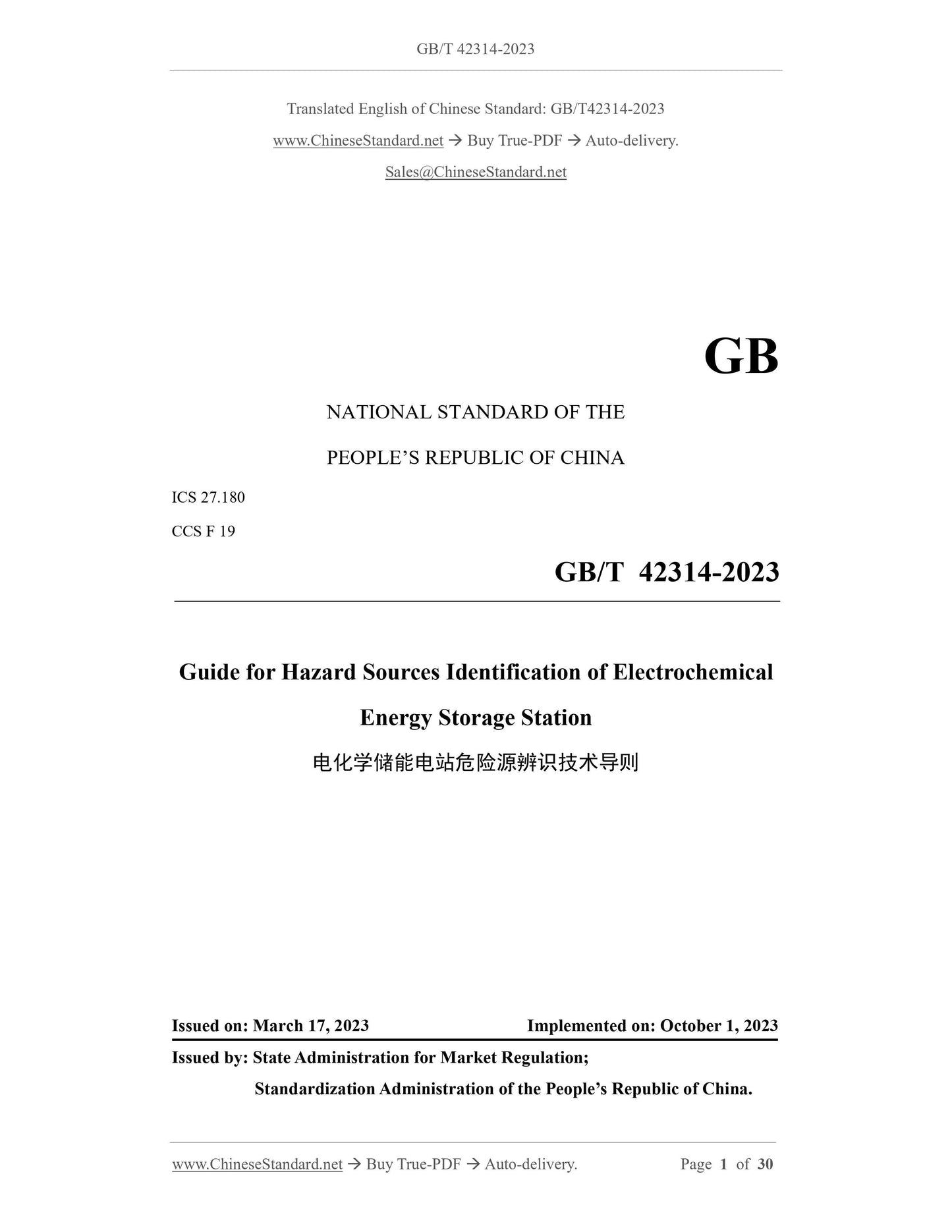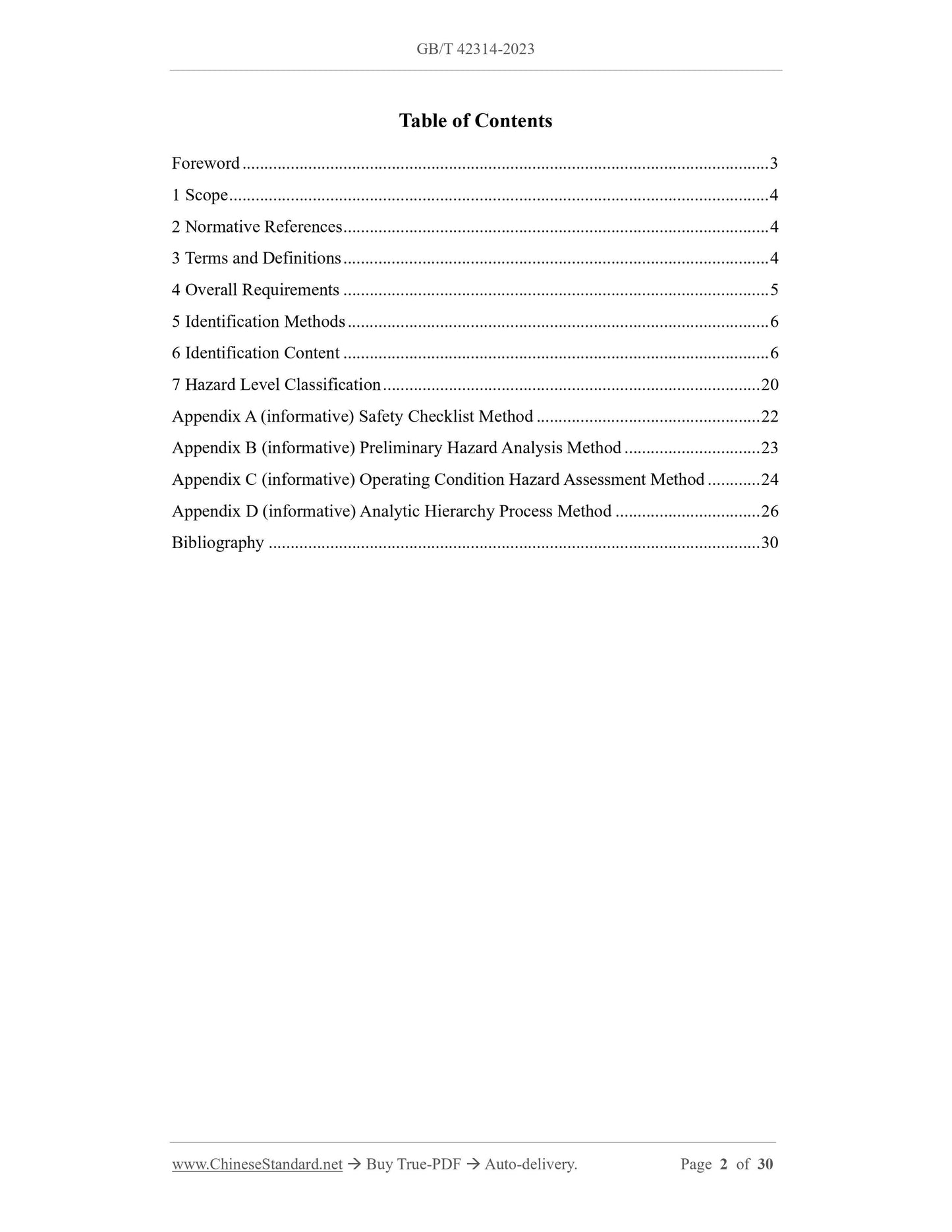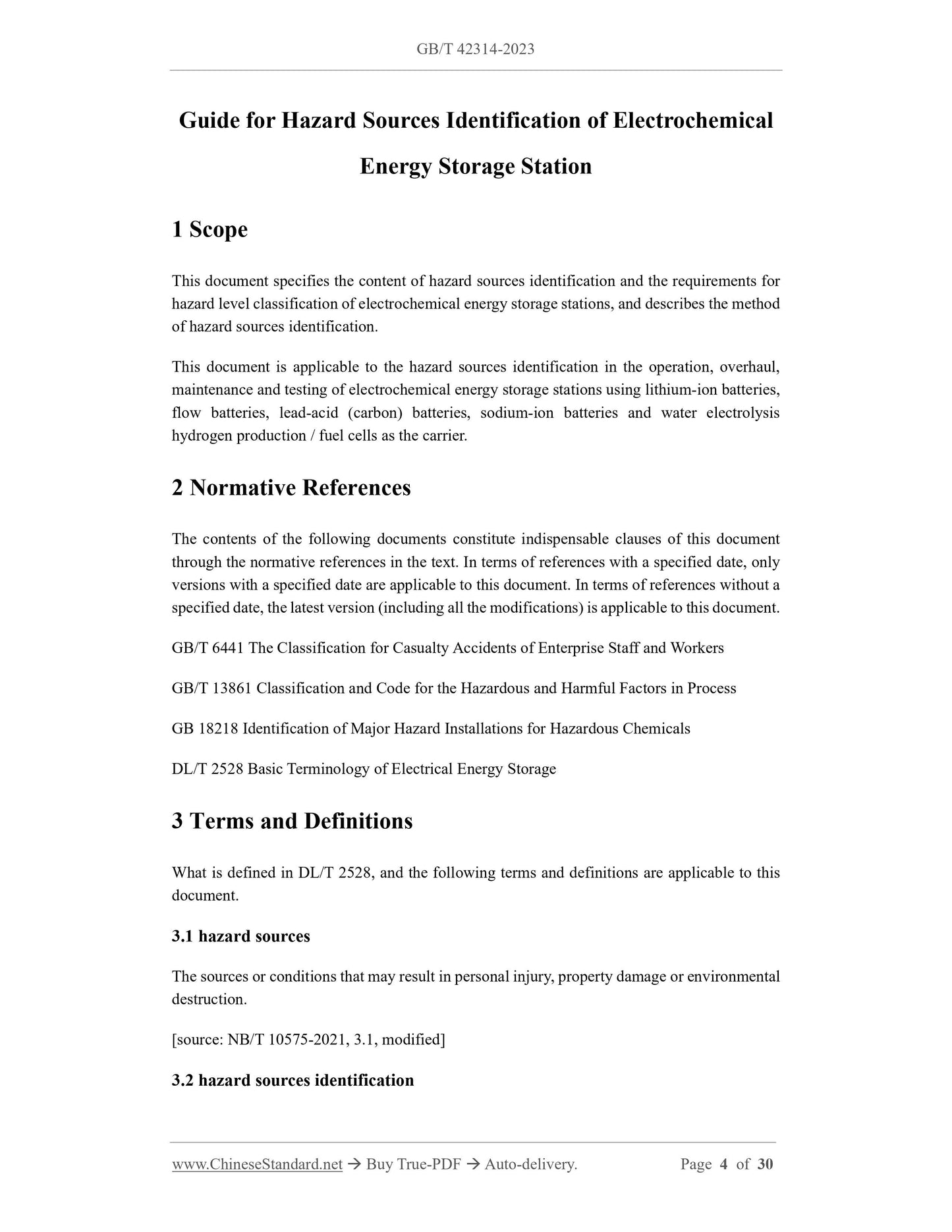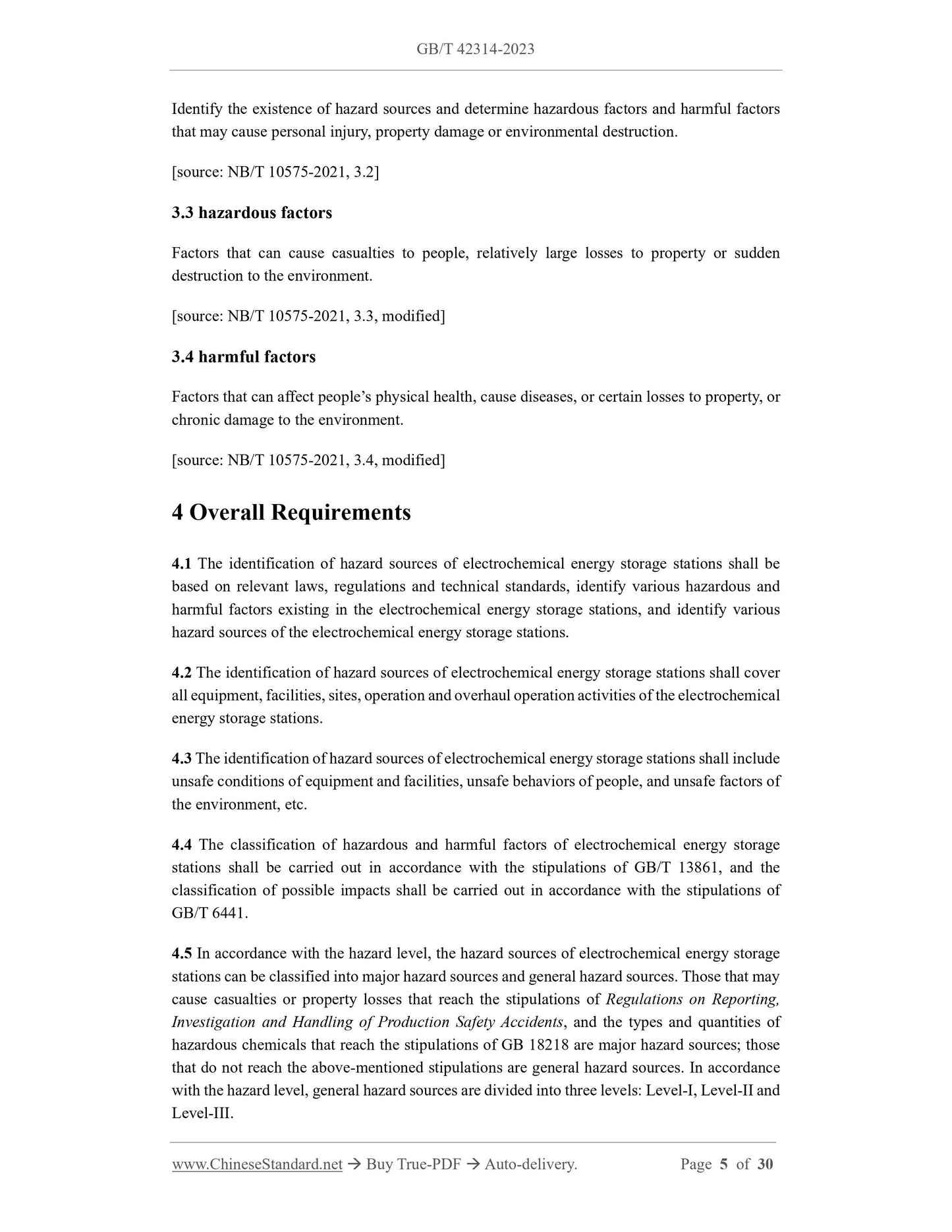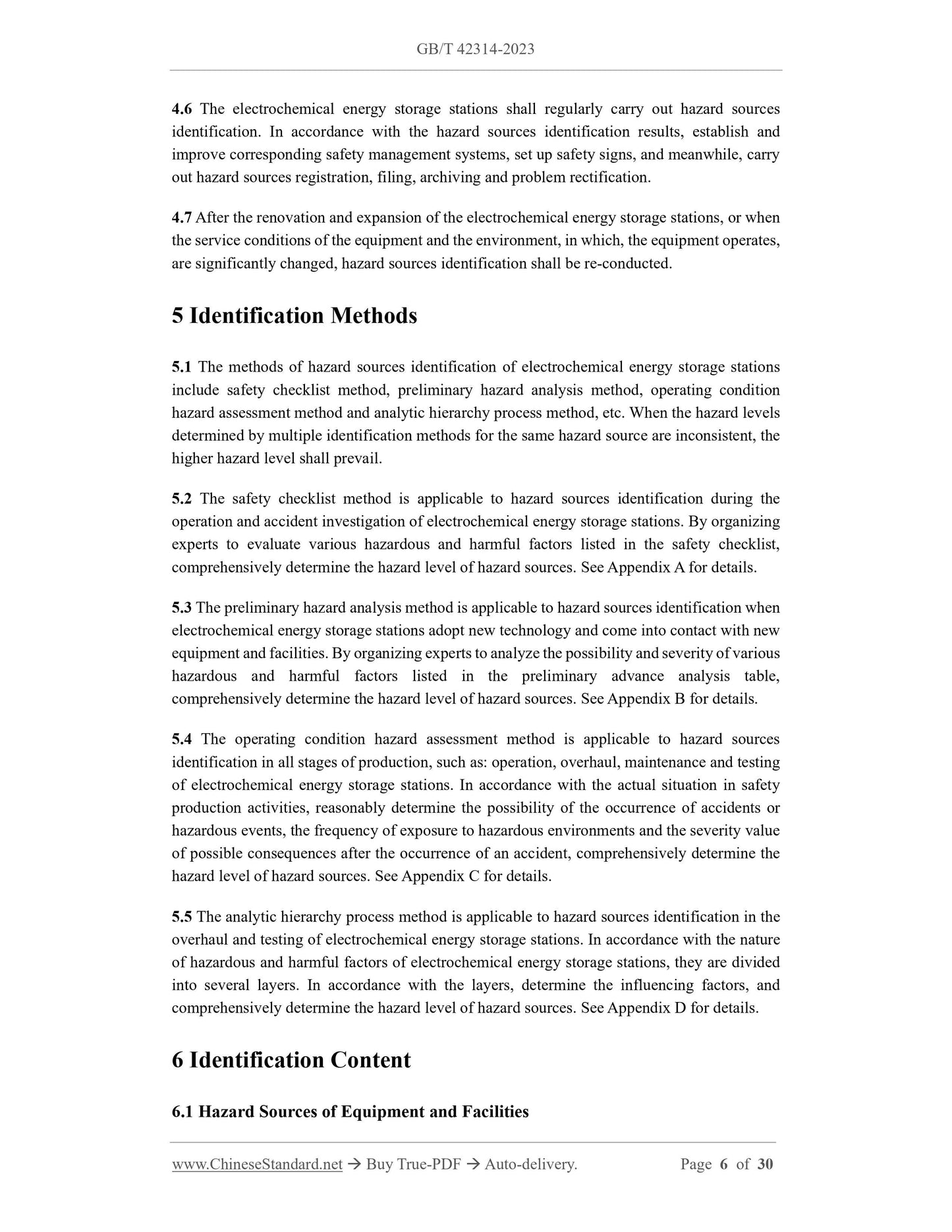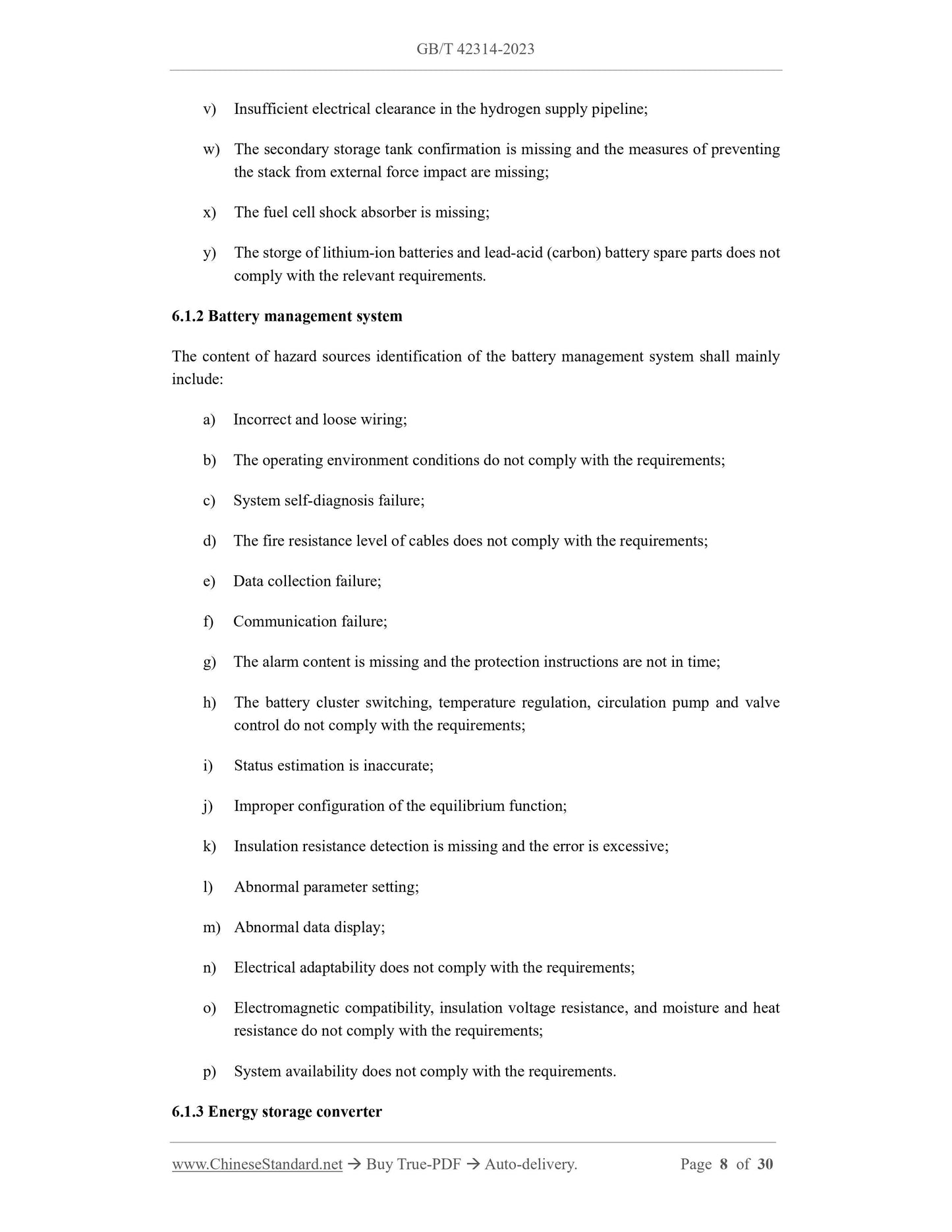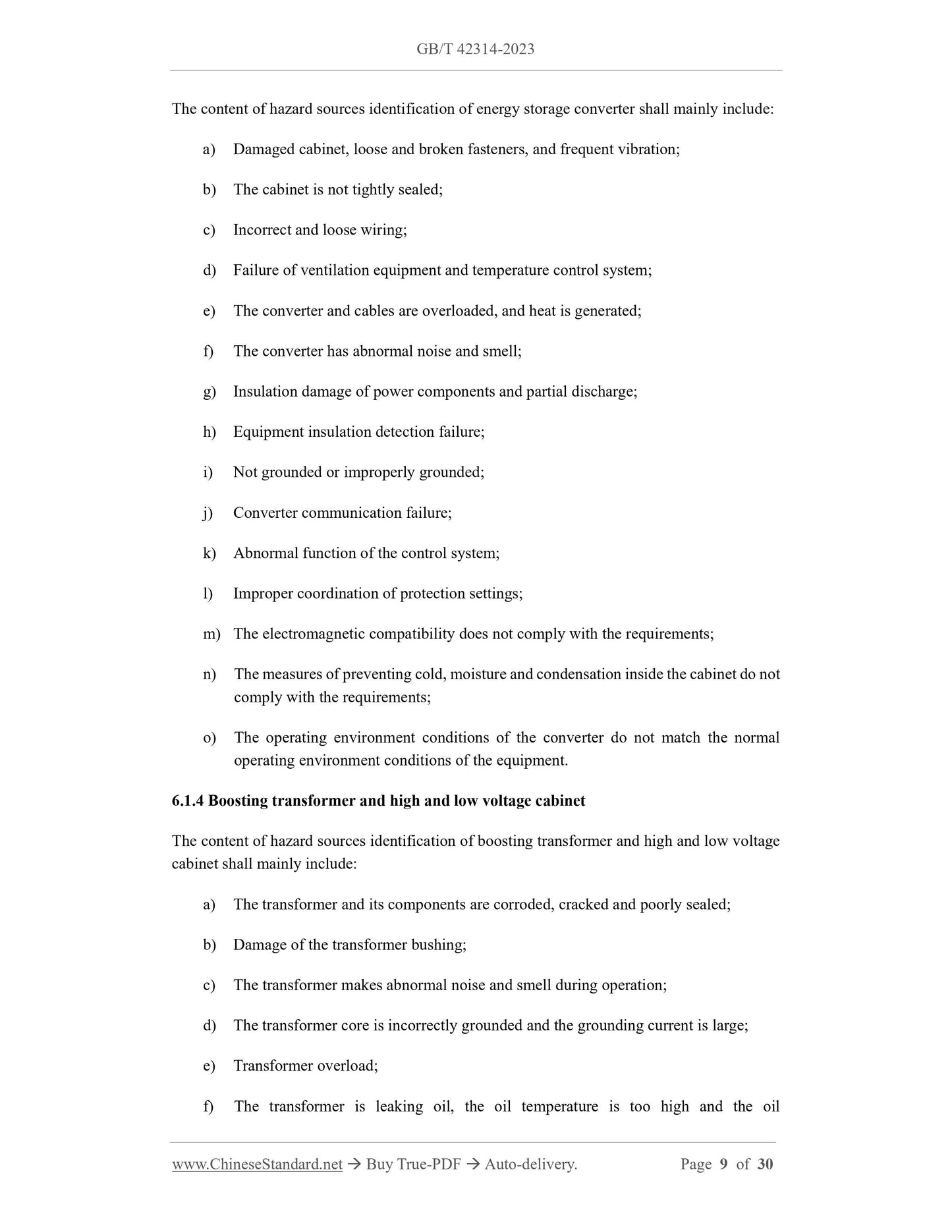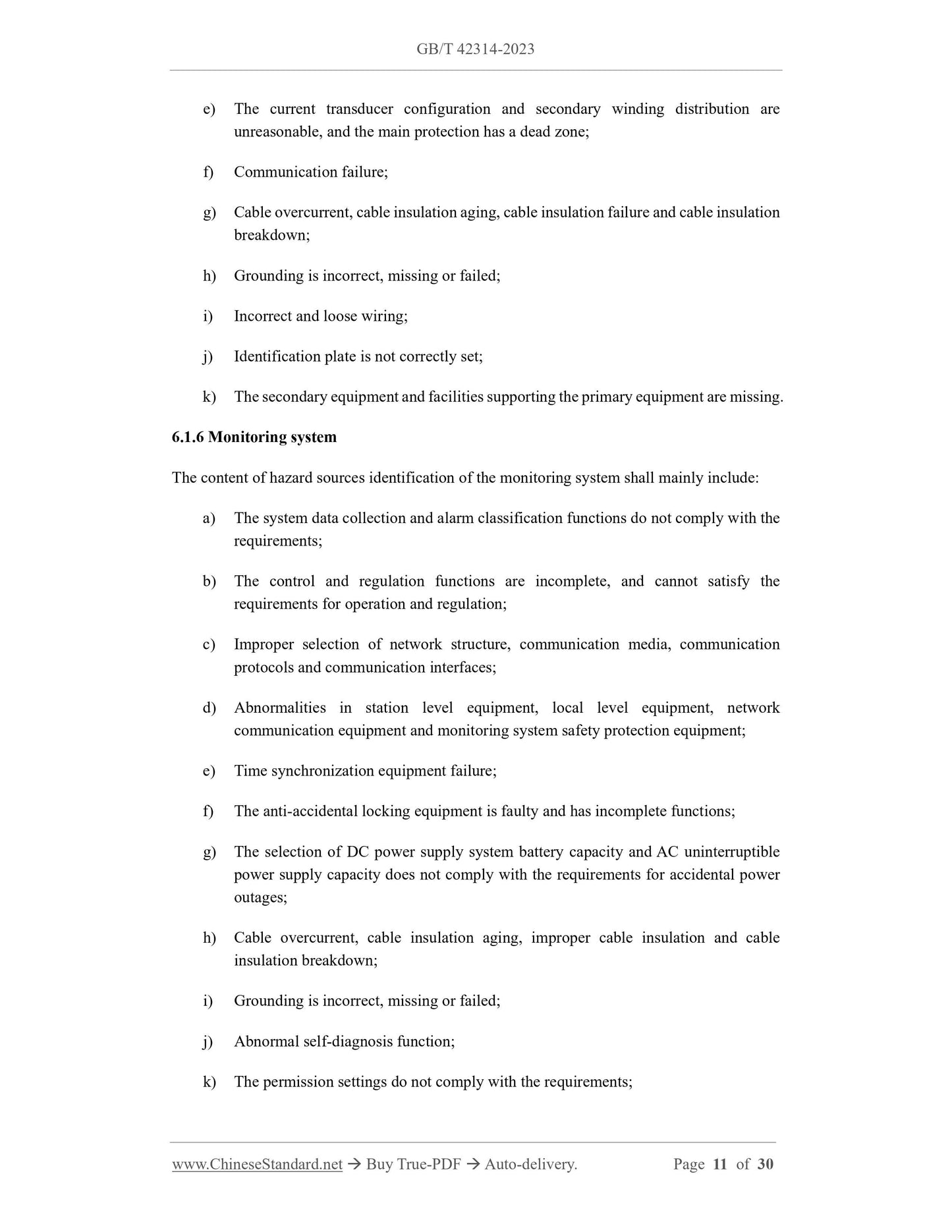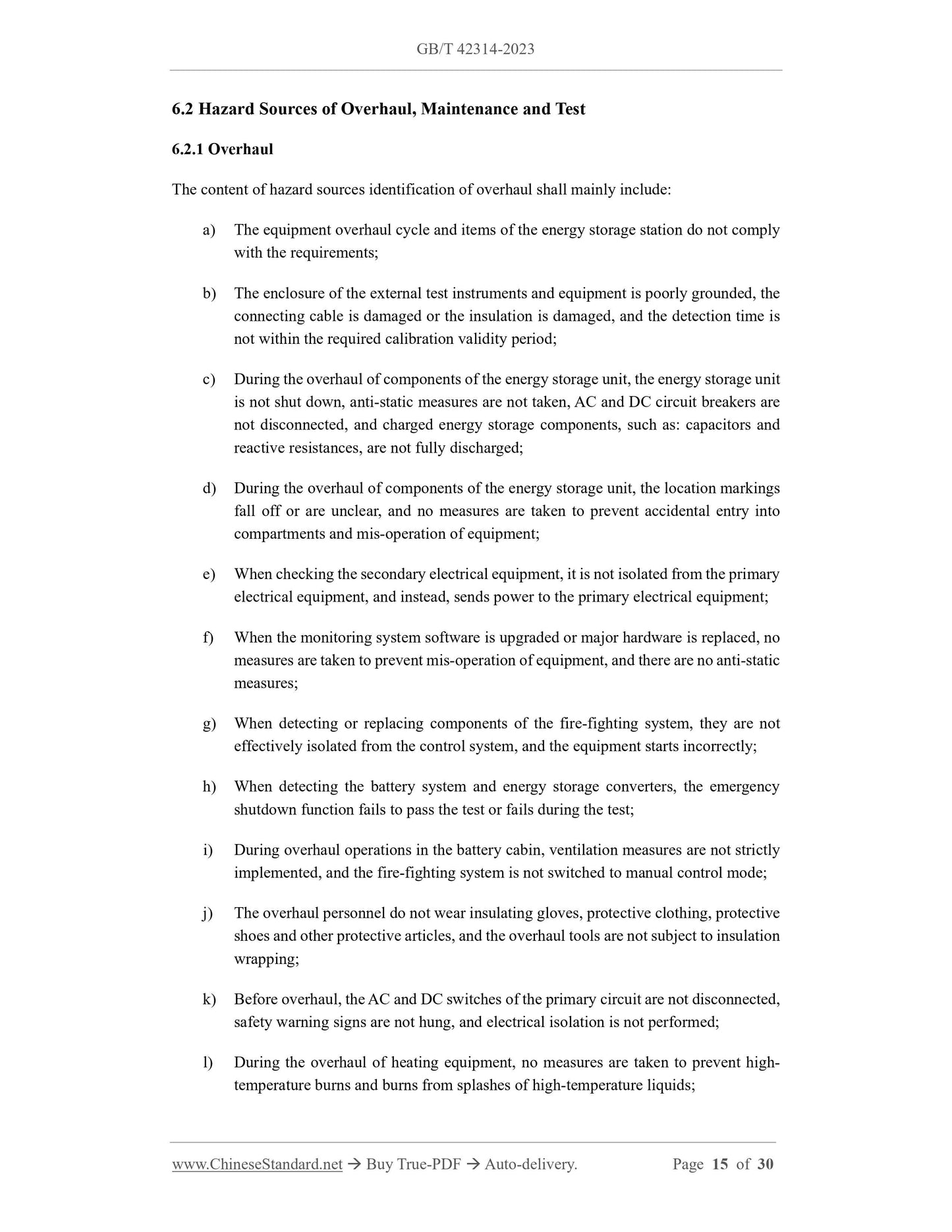1
/
of
12
PayPal, credit cards. Download editable-PDF and invoice in 1 second!
GB/T 42314-2023 English PDF (GBT42314-2023)
GB/T 42314-2023 English PDF (GBT42314-2023)
Regular price
$365.00 USD
Regular price
Sale price
$365.00 USD
Unit price
/
per
Shipping calculated at checkout.
Couldn't load pickup availability
Delivery: 3 seconds. Download true-PDF + Invoice.
Get QUOTATION in 1-minute: Click GB/T 42314-2023
Historical versions: GB/T 42314-2023
Preview True-PDF (Reload/Scroll if blank)
GB/T 42314-2023: Guide for hazard sources identification of electrochemical energy storage station
GB/T 42314-2023
GB
NATIONAL STANDARD OF THE
PEOPLE’S REPUBLIC OF CHINA
ICS 27.180
CCS F 19
Guide for Hazard Sources Identification of Electrochemical
Energy Storage Station
ISSUED ON: MARCH 17, 2023
IMPLEMENTED ON: OCTOBER 1, 2023
Issued by: State Administration for Market Regulation;
Standardization Administration of the People’s Republic of China.
Table of Contents
Foreword ... 3
1 Scope ... 4
2 Normative References ... 4
3 Terms and Definitions ... 4
4 Overall Requirements ... 5
5 Identification Methods ... 6
6 Identification Content ... 6
7 Hazard Level Classification ... 20
Appendix A (informative) Safety Checklist Method ... 22
Appendix B (informative) Preliminary Hazard Analysis Method ... 23
Appendix C (informative) Operating Condition Hazard Assessment Method ... 24
Appendix D (informative) Analytic Hierarchy Process Method ... 26
Bibliography ... 30
Guide for Hazard Sources Identification of Electrochemical
Energy Storage Station
1 Scope
This document specifies the content of hazard sources identification and the requirements for
hazard level classification of electrochemical energy storage stations, and describes the method
of hazard sources identification.
This document is applicable to the hazard sources identification in the operation, overhaul,
maintenance and testing of electrochemical energy storage stations using lithium-ion batteries,
flow batteries, lead-acid (carbon) batteries, sodium-ion batteries and water electrolysis
hydrogen production / fuel cells as the carrier.
2 Normative References
The contents of the following documents constitute indispensable clauses of this document
through the normative references in the text. In terms of references with a specified date, only
versions with a specified date are applicable to this document. In terms of references without a
specified date, the latest version (including all the modifications) is applicable to this document.
GB/T 6441 The Classification for Casualty Accidents of Enterprise Staff and Workers
GB/T 13861 Classification and Code for the Hazardous and Harmful Factors in Process
GB 18218 Identification of Major Hazard Installations for Hazardous Chemicals
DL/T 2528 Basic Terminology of Electrical Energy Storage
3 Terms and Definitions
What is defined in DL/T 2528, and the following terms and definitions are applicable to this
document.
3.1 hazard sources
The sources or conditions that may result in personal injury, property damage or environmental
destruction.
[source: NB/T 10575-2021, 3.1, modified]
3.2 hazard sources identification
Identify the existence of hazard sources and determine hazardous factors and harmful factors
that may cause personal injury, property damage or environmental destruction.
[source: NB/T 10575-2021, 3.2]
3.3 hazardous factors
Factors that can cause casualties to people, relatively large losses to property or sudden
destruction to the environment.
[source: NB/T 10575-2021, 3.3, modified]
3.4 harmful factors
Factors that can affect people’s physical health, cause diseases, or certain losses to property, or
chronic damage to the environment.
[source: NB/T 10575-2021, 3.4, modified]
4 Overall Requirements
4.1 The identification of hazard sources of electrochemical energy storage stations shall be
based on relevant laws, regulations and technical standards, identify various hazardous and
harmful factors existing in the electrochemical energy storage stations, and identify various
hazard sources of the electrochemical energy storage stations.
4.2 The identification of hazard sources of electrochemical energy storage stations shall cover
all equipment, facilities, sites, operation and overhaul operation activities of the electrochemical
energy storage stations.
4.3 The identification of hazard sources of electrochemical energy storage stations shall include
unsafe conditions of equipment and facilities, unsafe behaviors of people, and unsafe factors of
the environment, etc.
4.4 The classification of hazardous and harmful factors of electrochemical energy storage
stations shall be carried out in accordance with the stipulations of GB/T 13861, and the
classification of possible impacts shall be carried out in accordance with the stipulations of
GB/T 6441.
4.5 In accordance with the hazard level, the hazard sources of electrochemical energy storage
stations can be classified into major hazard sources and general hazard sources. Those that may
cause casualties or property losses that reach the stipulations of Regulations on Reporting,
Investigation and Handling of Production Safety Accidents, and the types and quantities of
hazardous chemicals that reach the stipulations of GB 18218 are major hazard sources; those
that do not reach the above-mentioned stipulations are general hazard sources. In accordance
with the hazard level, general hazard sources are divided into three levels: Level-I, Level-II and
Level-III.
4.6 The electrochemical energy storage stations shall regularly carry out hazard sources
identification. In accordance with the hazard sources identification results, establish and
improve corresponding safety management systems, set up safety signs, and meanwhile, carry
out hazard sources registration, filing, archiving and problem rectification.
4.7 After the renovation and expansion of the electrochemical energy storage stations, or when
the service conditions of the equipment and the environment, in which, the equipment operates,
are significantly changed, hazard sources identification shall be re-conducted.
5 Identification Methods
5.1 The methods of hazard sources identification of electrochemical energy storage stations
include safety checklist method, preliminary hazard analysis method, operating condition
hazard assessment method and analytic hierarchy process method, etc. When the hazard levels
determined by multiple identification methods for the same hazard source are inconsistent, the
higher hazard level shall prevail.
5.2 The safety checklist method is applicable to hazard sources identification during the
operation and accident investigation of electrochemical energy storage stations. By organizing
experts to evaluate various hazardous and harmful factors listed in the safety checklist,
comprehensively determine the hazard level of hazard sources. See Appendix A for details.
5.3 The preliminary hazard analysis method is applicable to hazard sources identification when
electrochemical energy storage stations adopt new technology and come into contact with new
equipment and facilities. By organizing experts to analyze the possibility and severity of various
hazardous and harmful factors listed in the preliminary advance analysis table,
comprehensively determine the hazard level of hazard sources. See Appendix B for details.
5.4 The operating condition hazard assessment method is applicable to hazard sources
identification in all stages of production, such as: operation, overhaul, maintenance and testing
of electrochemical energy storage stations. In accordance with the actual situation in safety
production activities, reasonably determine the possibility of the occurrence of accidents or
hazardous events, the frequency of exposure to hazardous environments and the severity value
of possible consequences after the occurrence of an accident, comprehensively determine the
hazard level of hazard sources. See Appendix C for details.
5.5 The analytic hierarchy process met...
Get QUOTATION in 1-minute: Click GB/T 42314-2023
Historical versions: GB/T 42314-2023
Preview True-PDF (Reload/Scroll if blank)
GB/T 42314-2023: Guide for hazard sources identification of electrochemical energy storage station
GB/T 42314-2023
GB
NATIONAL STANDARD OF THE
PEOPLE’S REPUBLIC OF CHINA
ICS 27.180
CCS F 19
Guide for Hazard Sources Identification of Electrochemical
Energy Storage Station
ISSUED ON: MARCH 17, 2023
IMPLEMENTED ON: OCTOBER 1, 2023
Issued by: State Administration for Market Regulation;
Standardization Administration of the People’s Republic of China.
Table of Contents
Foreword ... 3
1 Scope ... 4
2 Normative References ... 4
3 Terms and Definitions ... 4
4 Overall Requirements ... 5
5 Identification Methods ... 6
6 Identification Content ... 6
7 Hazard Level Classification ... 20
Appendix A (informative) Safety Checklist Method ... 22
Appendix B (informative) Preliminary Hazard Analysis Method ... 23
Appendix C (informative) Operating Condition Hazard Assessment Method ... 24
Appendix D (informative) Analytic Hierarchy Process Method ... 26
Bibliography ... 30
Guide for Hazard Sources Identification of Electrochemical
Energy Storage Station
1 Scope
This document specifies the content of hazard sources identification and the requirements for
hazard level classification of electrochemical energy storage stations, and describes the method
of hazard sources identification.
This document is applicable to the hazard sources identification in the operation, overhaul,
maintenance and testing of electrochemical energy storage stations using lithium-ion batteries,
flow batteries, lead-acid (carbon) batteries, sodium-ion batteries and water electrolysis
hydrogen production / fuel cells as the carrier.
2 Normative References
The contents of the following documents constitute indispensable clauses of this document
through the normative references in the text. In terms of references with a specified date, only
versions with a specified date are applicable to this document. In terms of references without a
specified date, the latest version (including all the modifications) is applicable to this document.
GB/T 6441 The Classification for Casualty Accidents of Enterprise Staff and Workers
GB/T 13861 Classification and Code for the Hazardous and Harmful Factors in Process
GB 18218 Identification of Major Hazard Installations for Hazardous Chemicals
DL/T 2528 Basic Terminology of Electrical Energy Storage
3 Terms and Definitions
What is defined in DL/T 2528, and the following terms and definitions are applicable to this
document.
3.1 hazard sources
The sources or conditions that may result in personal injury, property damage or environmental
destruction.
[source: NB/T 10575-2021, 3.1, modified]
3.2 hazard sources identification
Identify the existence of hazard sources and determine hazardous factors and harmful factors
that may cause personal injury, property damage or environmental destruction.
[source: NB/T 10575-2021, 3.2]
3.3 hazardous factors
Factors that can cause casualties to people, relatively large losses to property or sudden
destruction to the environment.
[source: NB/T 10575-2021, 3.3, modified]
3.4 harmful factors
Factors that can affect people’s physical health, cause diseases, or certain losses to property, or
chronic damage to the environment.
[source: NB/T 10575-2021, 3.4, modified]
4 Overall Requirements
4.1 The identification of hazard sources of electrochemical energy storage stations shall be
based on relevant laws, regulations and technical standards, identify various hazardous and
harmful factors existing in the electrochemical energy storage stations, and identify various
hazard sources of the electrochemical energy storage stations.
4.2 The identification of hazard sources of electrochemical energy storage stations shall cover
all equipment, facilities, sites, operation and overhaul operation activities of the electrochemical
energy storage stations.
4.3 The identification of hazard sources of electrochemical energy storage stations shall include
unsafe conditions of equipment and facilities, unsafe behaviors of people, and unsafe factors of
the environment, etc.
4.4 The classification of hazardous and harmful factors of electrochemical energy storage
stations shall be carried out in accordance with the stipulations of GB/T 13861, and the
classification of possible impacts shall be carried out in accordance with the stipulations of
GB/T 6441.
4.5 In accordance with the hazard level, the hazard sources of electrochemical energy storage
stations can be classified into major hazard sources and general hazard sources. Those that may
cause casualties or property losses that reach the stipulations of Regulations on Reporting,
Investigation and Handling of Production Safety Accidents, and the types and quantities of
hazardous chemicals that reach the stipulations of GB 18218 are major hazard sources; those
that do not reach the above-mentioned stipulations are general hazard sources. In accordance
with the hazard level, general hazard sources are divided into three levels: Level-I, Level-II and
Level-III.
4.6 The electrochemical energy storage stations shall regularly carry out hazard sources
identification. In accordance with the hazard sources identification results, establish and
improve corresponding safety management systems, set up safety signs, and meanwhile, carry
out hazard sources registration, filing, archiving and problem rectification.
4.7 After the renovation and expansion of the electrochemical energy storage stations, or when
the service conditions of the equipment and the environment, in which, the equipment operates,
are significantly changed, hazard sources identification shall be re-conducted.
5 Identification Methods
5.1 The methods of hazard sources identification of electrochemical energy storage stations
include safety checklist method, preliminary hazard analysis method, operating condition
hazard assessment method and analytic hierarchy process method, etc. When the hazard levels
determined by multiple identification methods for the same hazard source are inconsistent, the
higher hazard level shall prevail.
5.2 The safety checklist method is applicable to hazard sources identification during the
operation and accident investigation of electrochemical energy storage stations. By organizing
experts to evaluate various hazardous and harmful factors listed in the safety checklist,
comprehensively determine the hazard level of hazard sources. See Appendix A for details.
5.3 The preliminary hazard analysis method is applicable to hazard sources identification when
electrochemical energy storage stations adopt new technology and come into contact with new
equipment and facilities. By organizing experts to analyze the possibility and severity of various
hazardous and harmful factors listed in the preliminary advance analysis table,
comprehensively determine the hazard level of hazard sources. See Appendix B for details.
5.4 The operating condition hazard assessment method is applicable to hazard sources
identification in all stages of production, such as: operation, overhaul, maintenance and testing
of electrochemical energy storage stations. In accordance with the actual situation in safety
production activities, reasonably determine the possibility of the occurrence of accidents or
hazardous events, the frequency of exposure to hazardous environments and the severity value
of possible consequences after the occurrence of an accident, comprehensively determine the
hazard level of hazard sources. See Appendix C for details.
5.5 The analytic hierarchy process met...
Share
